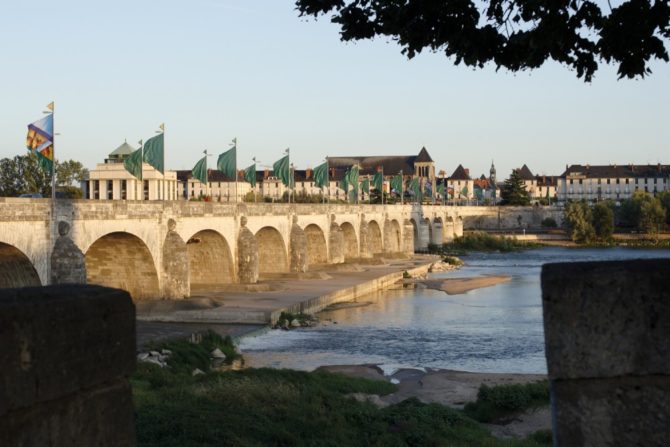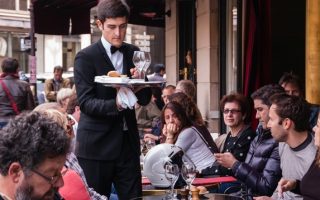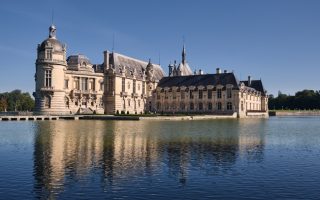The Lovely, Laid-Back City of Tours

Beneath the plane trees lining Boulevard Béranger, the twice-weekly flower market in Tours provides a splash of color and a heady whiff of fragrance to the thoroughfare, one of several that can justly be described as Haussmannesque. The imposing Belle Epoque City Hall, built by noted native-son architect Victor Laloux bears more than a passing resemblance to the Hôtel de Ville in the nation’s capital. Echoes of the Paris Opéra are found in the opulent Grand Théâtre de Tours, since architect Charles Garnier was involved in its construction. Towering Saint Gatien cathedral, in spite of its ornate facade and owl-eyed twin towers topped with Renaissance belfries, is, on the interior, a Gothic marvel fit for Quasimodo. And in the summer—inspired by the success of Paris Plage—Tours puts on its own beach-party festival on the banks of the Loire, with evening concerts, open-air movies and guinguettes for dancing.
“Tours? C’est le mini-Paris!” That’s how the local Tourangeaux describe their lovely city on the Loire, which has, on several occasions, stood in for Paris as the capital of France. The bold comparison—spoken in what is claimed to be the purest French in the entire country—must surely provoke some nose-wrinkling among proud Parisians. But even the most partisan Parigot must recognize that provincial Tours does have much in common with the City of Light, albeit on a much smaller—and, some might say, more human and friendlier—scale.
But if Tours harbors a thinly concealed rivalry with its larger sibling on the Seine, it’s remarkably laid-back about it—that’s what makes the city so appealing. Paris may be the nation’s pacesetter, but Tours somehow manages to never fall too far behind and still take time to smell the roses. The easygoing approach to life in the Touraine has given birth to the expression le quart d’heure Tourangeau, which essentially means you shouldn’t expect anything to start until 15 minutes after the scheduled time. Even the Loire seems in no great rush to get to the sea, normally preferring to proclaim its existence in a pleasant purr rather than a threatening roar.
It’s easy to see why Tours is used as a base by many of the estimated nine million tourists who come every year to visit the Renaissance châteaux of the Loire. Centrally located within an hour or so of all the most important châteaux, its modern transport links—it’s only an hour by TGV from central Paris—and its wide array of restaurants, hotels and other amenities make it a logical hub. But Tours offers visitors much more than just a place to wine, dine and rest after a long day exploring Chenonceau or the extraordinary gardens of Villandry. The city has many attractions of its own to help castled-out tourists recharge their batteries.
Cobbled streets and cafés
The Loire gives Tours its scenic setting, but it’s also the most useful reference when navigating the city, which is actually sandwiched between two rivers: the Loire and the Cher. Urban sprawl has extended, in a not always prepossessing fashion, far beyond both rivers, so it’s the area closest to the Loire that merits the most attention. It’s not a bad idea to start a tour of Tours with a lazy stroll along the banks of the great river—on the western end of the city there’s a mini-promenade under weeping willows dangling their wistful tendrils into the languorous current. Rue Nationale, running perpendicular to the river across the center of town, is lined with shops all the way to the Mairie and the elegant fountains and flowerbeds of the Place Jean Jaurès, dividing the city into two distinct sections, with Vieux Tours to the west and the cathedral quarter to the east.
Vieux Tours is technically a misnomer—the Gallo-Roman area in the cathedral quarter predates medieval Tours by quite a few centuries. But the beguiling maze of cobbled streets is lined with 14th- to 16th-century half-timbered and slate-clad townhouses adorned with exquisitely carved figures. All the cobbled arteries lead to the pedestrian Place Plumereau, a carefully preserved jewel of late medieval architecture.
There’s something irresistibly appealing about sitting in Place Plum’ (pronounced like the feather, not the fruit) and absorbing the atmosphere. In the shade of parasols and café awnings, local residents, students and tourists converse while sipping coffee and nursing glasses of sparkling Vouvray wine. Children lick artisanale ice cream under the old mulberry tree, and avid eaters lunch on copious salads, topped with goat’s cheese from Sainte-Maure de Touraine, and toast slathered with rillettes de porc (a regional specialty of spreadable pork pâté).
The jumbled streets around Place Plumereau offer a good choice of chic restaurants and bars, while an equally diverse but more international flavor is found along rue Colbert, which starts on the other side of rue Nationale and leads to the cathedral quarter. Rue Colbert is the preferred hangout of many of the city’s 30,000-odd students, so there are plenty of budget-friendly restaurants on hand. At number 39/41, a plaque marks the half-timbered house of the armurier who made Joan of Arc’s armor in 1429, before she set off to lift the siege of Orléans.
Few more pleasing…
Farther down rue Colbert, Saint Gatien cathedral leaps out of the city skyline. The evolution of medieval architecture is writ large on the ornate facade, reflecting the 13th- to 16th-century progression from Romanesque to flamboyant Gothic to early Renaissance, but the great church miraculously manages to avoid looking like a stylistic mishmash. The interior houses the elaborate white marble tomb of two princes—the children of Anne de Bretagne and Charles VIII—who died in their infancy, marking the end of the royal Valois dynasty in France.
There’s also some magnificent stained glass, including smaller-scale ripostes to the rose windows of Notre Dame de Paris. On clear days, the sunlight streaming through the windows over the choir throws magical polychrome patterns on the floor of the ambulatory. Just outside, the cathedral’s two-story cloister, known as La Psalette because that’s where psalms were sung, has a graceful, circular Renaissance staircase in one corner. Henry James, during his visit to Tours in 1882, summed up Saint Gatien best: “There are many grander cathedrals, but there are probably few more pleasing.”
A short walk from Saint Gatien, the Musée des Beaux-Arts occupies the former 17th/18th-century episcopal palace. The courtyard entrance harbors a living chef d’oeuvre: an enormous cedar of Lebanon, planted in 1804 and now one of the largest in Europe. The museum houses a surprisingly rich collection of paintings, sculptures and furniture, including works by Rubens, Rembrandt, Mantegna, Monet, Degas and
Delacroix, among many others. There are also two portraits and a Rodin statue of novelist Honoré de Balzac, who was born in Tours and spent a good portion of his adult life writing, and hiding from Parisian creditors, in the region. Outside the museum a small, attractive formal garden offers a fine view of the former palace and the cathedral.
Visitors may find themselves wondering why the cathedral quarter is nearly a mile from Old Tours: the answer is that Tours is actually two distinct settlements grown together. When the Celtic Turone tribe first established their settlement here, it was on the northern side of the Loire. The Romans arrived in the 1st century, and with characteristic imperiousness transferred the settlement south to its current site and re-named it Caesarodunum, Caesar’s Hill. As industrious as they were imperious, the Romans built a large protective wall around the settlement, significant traces of which can still be seen in the garden of the Musée des Beaux-Arts and rue des Ursulines. They also built an amphitheater large enough to seat 34,000 spectators, making it one of the five largest in the Roman Empire. Only the arena’s foundations remain, in the cellars of private mansions, but the curving outline of the amphitheater can still be traced on rue du Général Meunier. The cathedral quarter that grew up around Saint Gatien was built on the site of the Roman settlement.
Saints and Charlemagne
The Romans left their indelible mark on Tours, as in many parts of France, but it was one ex-Roman soldier in particular who would dramatically shape the city’s history. Famed for cutting his military cloak in half to share with a beggar, Saint Martin of Tours died in 397, and he quickly thereafter became one of the most important Catholic saints. The cult of Saint Martin grew in importance as he was adopted as a patron saint, first by the Merovingian and then the Carolingian kings of the Franks. The original basilica of Saint Martin, built a good 20-minute walk from the Roman town, housed the saint’s shrine; in the early Middle Ages it was considered the third most important pilgrimage site in Christendom, after Jerusalem and Rome. Much of Martin’s early posthumous popularity, in fact, was due to the writings of the city’s second major saint, Grégoire de Tours, a 6th-century bishop and prominent historian who wrote a history of the Franks and many accounts of miracles attributed to Martin.
The great wealth of the basilica of Saint Martin was a tempting target to marauders, and in fact was the intended destination of the Saracen army defeated by Charles Martel—Charlemagne’s grandfather—in 732 in the Battle of Tours (also called the Battle of Poitiers). Walls were built to protect the new settlement that sprang up around the basilica to host the pilgrims, so that until the 14th century Tours was actually two separate entities. It was only in the late Middle Ages, as the region prospered from the silk trade and the royal favor of Louis XI, that the area between the two settlements developed, effectively fusing them.
The basilica was destroyed and rebuilt several times, eventually succumbing to Viking and Norman raids, fire, religious wars and revolution. But vestiges of the medieval structure remain on rue de Châteauneuf, notably Charlemagne’s Tower—the Frankish king’s last wife, Luitgarde, is said to be buried there. In the late 19th and early 20th century, architect Victor Laloux built a new, neo-Byzantine basilica on the site of the old one. (Laloux also built the train station in Tours and another, in Paris, that eventually became the Musée d’Orsay.)
Built at the same time as Sacré Coeur in Paris, the basilica is a more restrained affair than its grandiose cousin; Saint Martin’s tomb, in the crypt, still draws pilgrims more than 1500 years after the saint’s death.
Like Paris, Tours is sometimes described as bourgeois. That may be considered good or bad, but it is undoubtedly true, in more ways than one. When most people call Tours “bourgeois”, they’re referring to its air of unpretentious prosperity, visibly reflected in its wealth of gourmet restaurants, fine shops and impressive architecture. But in fact the first known French use of the word bourg dates from 837, when it was used to describe the walled settlement around the basilica. The Tourangeaux have every reason to be proud of it.
TOURS NOTEBOOK
Office de Tourisme 78 rue Bernard Palissy, 02.47.70.37.37. website
Museums
Musée des Beaux-Arts 18 place François Sicard, 02.47.05.68.73. website
Musée de Compagnonnage Dedicated to the works of artisans and master craftsmen, including shoemakers, bakers, carpenters, metalworkers and stonemasons. 8 rue Nationale, 02.47.21.62.20. website
Musée Saint Martin 3 rue Rapin, 02.47.64.48.87.
Hôtels
Hôtel de l’Univers The poshest hotel in town—former clients include Franklin Roosevelt, Henry James, Ernest Hemingway and Winston Churchill. 5 blvd Heurteloup, 02.47.05.37.12. website
L’Adresse Small, thoroughly charming hotel near Place Plumereau. 12 rue de la Rôtisserie, 02.47.20.85.76. website
Restaurants
Le Turon Quality French food and local specialties at reasonable prices. 94 rue Colbert, 02.47.66.14.25.
Comme Autrefouée Just off place Plum, an original dining experience in a medieval setting. The meal consists primarily of fouaces—a type of traditional wood-oven baked pita bread beloved by Rabelais’s Gargantua—filled with rillettes, haricots blancs or local goat cheese. 11 rue de la Monnaie, 02.47.05.94.78. website
Le Rive Gauche Modern ambiance, innovative cuisine. 23 rue de Commerce, 02.47.05.71.21. website
Bike Rentals
Détours de Loire 35 rue Charles Gilles, 02.47.61.22.23. website
Originally published in the May 2011 issue of France Today
Share to: Facebook Twitter LinkedIn Email
Leave a reply
Your email address will not be published. Required fields are marked *



